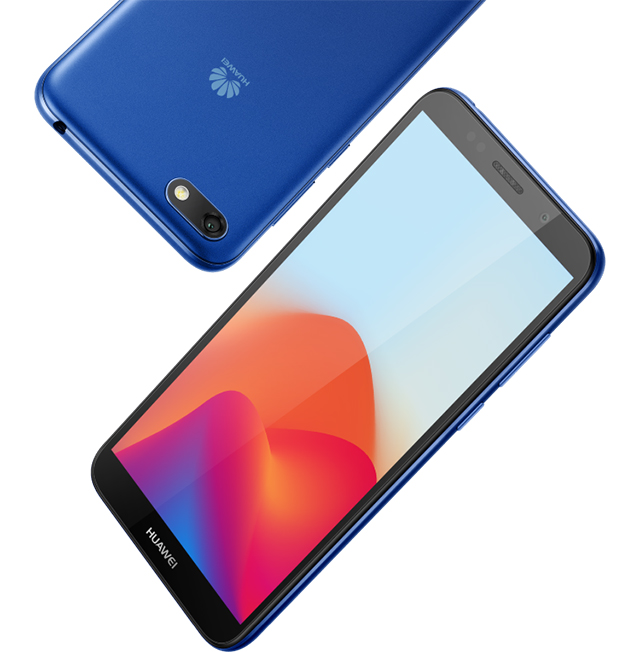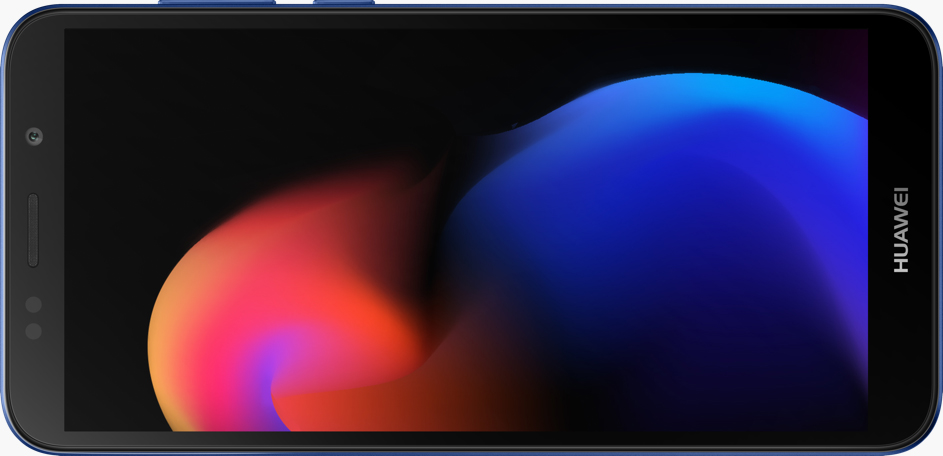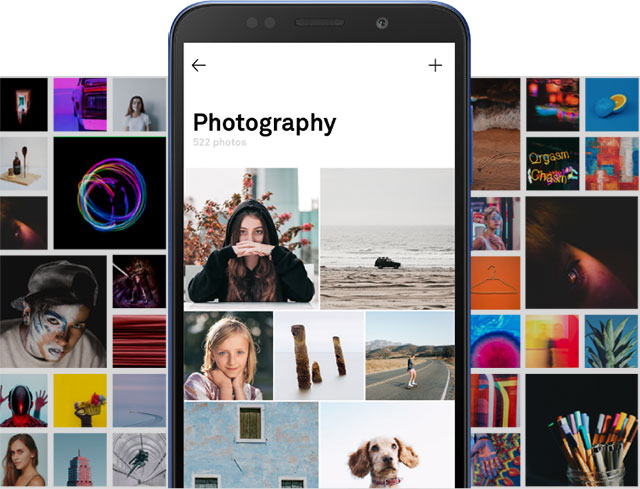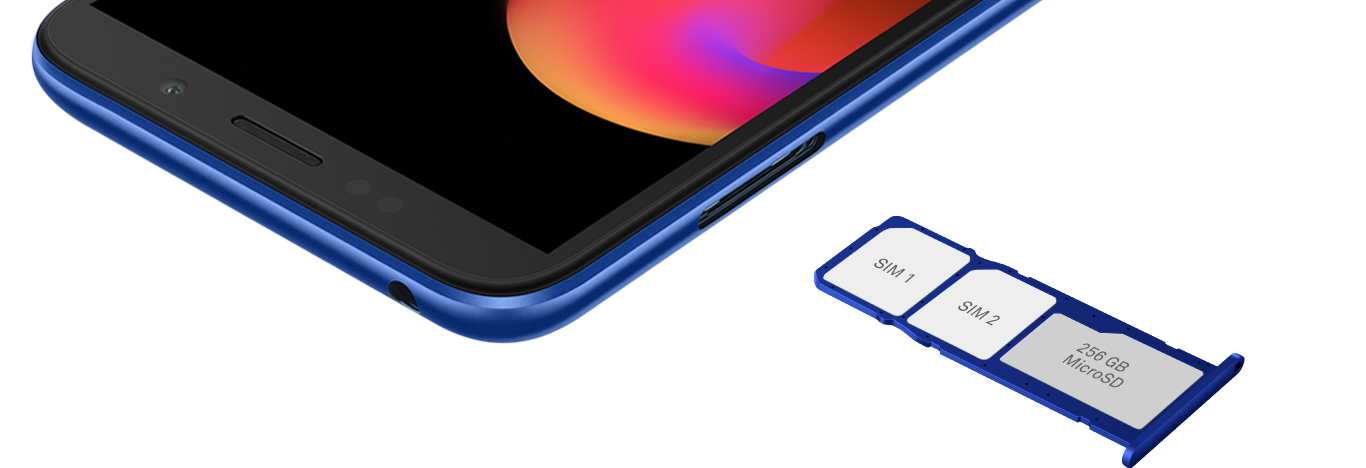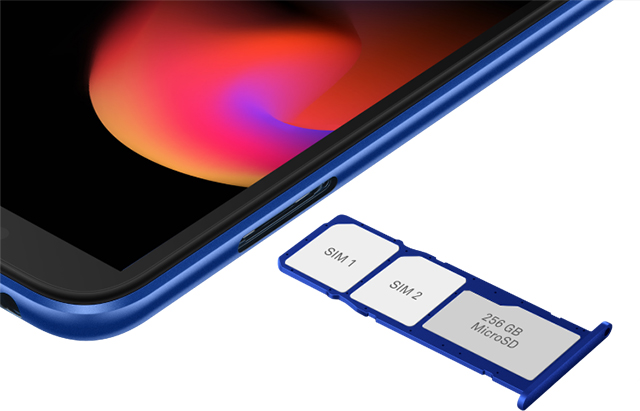Huawei y5 lite 2018
Huawei y5 lite 2018
HUAWEI Y5 lite
5.45″ HUAWEI
FullView Display
Vast Vision that Fits in Your Hand
The 5.45″ HUAWEI HD+ 1440 x 720 FullView Display outcompetes similar-range phones while delivering a vivid experience of the world into the palm of your hand.
Keep Going Longer
The HUAWEI Y5 lite holds a 3,020 mAh* battery bringing serious power for a long-lasting expierence. Let the fun begin.
* Typical value. Based on results from HUAWEI lab tests.


Large Memory to Keep Your Media, Photos, and Apps
16 GB of ROM memory gives you more room to keep the things you love while you’re making unforgettable memories. The internal memory provides plenty of space for your apps, photos, and media and can be expanded up to 256 GB with a micro SD card.
Capture the Beauty of Your World
The 8 MP rear camera with panorama mode helps you capture your big wide world. The selfie-optimised front camera makes you look gorgeous every time with beauty mode and selfie toning flash, even in low-light conditions.
* On screen photo is not taken by the product, but for illustration purposes.
More Fun with More Cards
Double SIM cards * help you to keep up with multiple worlds at once, so you can keep your work and home life in the palm of your hand. Additional expansion slot for micro SD card provides up to 256 GB of memory.
* HUAWEI Y5 lite has different models, single card and dual-sim card phone. Actual product may be different in some countries.
Clear Conversations in Noisy Environments
Responsive sound helps you hear better by compensating for the noise around you. Let the volume get adjusted automatically to help you hear clearly even in the noisy environments.
Huawei Y5 (2019) vs Huawei Y5 Lite (2018)
Почему Huawei Y5 (2019) лучше чем Huawei Y5 Lite (2018)?
Почему Huawei Y5 Lite (2018) лучше чем Huawei Y5 (2019)?
Какие сравнения самые популярные?
Huawei Y5 Lite (2018)
Huawei Y5 Prime (2018)
Huawei Y5 Prime (2018)
Huawei Y5 Lite (2018)
Huawei Mate 20 Lite
Huawei Y5 Lite (2018)
Samsung Galaxy J2 Prime
Huawei Mate 10 Lite
Huawei Y5 Lite (2018)
Samsung Galaxy A10s
Huawei Y5 Lite (2018)
Samsung Galaxy J5 (2016)
Huawei Y5 Lite (2018)
Samsung Galaxy A01
Huawei Y5 Lite (2018)
Huawei Y5 Lite (2018)
Huawei Y5 Lite (2018)
Huawei Y5 Lite (2018)
Отзывы пользователей
Общий рейтинг
Функции
Срок службы батареи
Комментарии
Будьте первым. Поделитесь своим опытом, чтобы помочь другим членам сообщества принять решение.
Дизайн
Неизвестно. Помогите нам, предложите стоимость. (Huawei Y5 (2019))
Неизвестно. Помогите нам, предложите стоимость. (Huawei Y5 Lite (2018))
Неизвестно. Помогите нам, предложите стоимость. (Huawei Y5 (2019))
Неизвестно. Помогите нам, предложите стоимость. (Huawei Y5 Lite (2018))
Неизвестно. Помогите нам, предложите стоимость. (Huawei Y5 (2019))
Неизвестно. Помогите нам, предложите стоимость. (Huawei Y5 Lite (2018))
Дисплей
Неизвестно. Помогите нам, предложите стоимость. (Huawei Y5 Lite (2018))
Неизвестно. Помогите нам, предложите стоимость. (Huawei Y5 (2019))
Неизвестно. Помогите нам, предложите стоимость. (Huawei Y5 Lite (2018))
Неизвестно. Помогите нам, предложите стоимость. (Huawei Y5 (2019))
Неизвестно. Помогите нам, предложите стоимость. (Huawei Y5 Lite (2018))
Производительность
Неизвестно. Помогите нам, предложите стоимость. (Huawei Y5 Lite (2018))
Неизвестно. Помогите нам, предложите стоимость. (Huawei Y5 (2019))
Неизвестно. Помогите нам, предложите стоимость. (Huawei Y5 Lite (2018))
Неизвестно. Помогите нам, предложите стоимость. (Huawei Y5 (2019))
Неизвестно. Помогите нам, предложите стоимость. (Huawei Y5 Lite (2018))
Неизвестно. Помогите нам, предложите стоимость. (Huawei Y5 (2019))
Неизвестно. Помогите нам, предложите стоимость. (Huawei Y5 Lite (2018))
Неизвестно. Помогите нам, предложите стоимость. (Huawei Y5 Lite (2018))
Dimensions: 70.9 x 146.5 x 8.3 mm
Weight: 142 g
SoC: MediaTek MT6752
CPU: ARM Cortex-A53, 1700 MHz, Cores: 8
GPU: ARM Mali-T760 MP2, 570 MHz, Cores: 2
RAM: 2 GB, 800 MHz
Storage: 16 GB
Memory cards: microSD, microSDHC, microSDXC
Display: 4.7 in, IPS, 720 x 1280 pixels, 24 bit
Battery: 2000 mAh, Li-Polymer
OS: Android 8.1 Oreo Go Edition
Camera: 4160 x 3120 pixels, 1920 x 1080 pixels, 30 fps
SIM card: Nano-SIM / microSD, Micro-SIM
Wi-Fi: b, g, n, Wi-Fi Hotspot, Wi-Fi Direct
USB: 2.0, Micro USB
Bluetooth: 4.0
Positioning: GPS, A-GPS, GLONASS, BeiDou
Brand and model
Information about the brand, model and model alias (if any) of a specific device.
Brand name of the company that manufactures the device.
Model name of the device.
Аlternative names, under which the model is known.
DRA-LX5
Design
Information about the dimensions and weight of the device, shown in different measurement units. Body materials, available colors, certifications.
Information about the width, i.e. the horizontal side of the device when it is used in its standard orientation.
7.09 cm (centimeters)
0.233 ft (feet)
2.791 in (inches)
Information about the height, i.e. the vertical side of the device when it is used in its standard orientation.
14.65 cm (centimeters)
0.481 ft (feet)
5.768 in (inches)
Information about the thickness/depth of the device in different measurement units.
0.83 cm (centimeters)
0.027 ft (feet)
0.327 in (inches)
Information about the weight of the device in different measurement units.
0.31 lbs (pounds)
5.01 oz (ounces)
Estimated volume of the device, calculated from the dimensions provided by the manufacturer. Applies for devices in the form of a rectangular parallelepiped.
5.24 in³ (cubic inches)
Information about the colors, in which the device is available in the market.
Black
Materials used in the fabrication of the device’s body.
Glass
SIM card
The Subscriber Identity Module (SIM) is used in mobile devices for storing data authenticating the subscribers of mobile services.
Information about the type and size (form factor) of the SIM card used in the device.
Information about the number of SIM cards, supported by the device.
Information about some specific features related to the SIM card(s) of the device.
Networks
A mobile (cellular) network is a radio system, which allows a large number of mobile devices to communicate with each other.
GSM (Global System for Mobile Communications) was developed to replace the analog cellular network (1G), therefore it is referred to as a 2G mobile network. It has been improved with the addition of General Packet Radio Services (GPRS) and later via the Enhanced Data rates for GSM Evolution (EDGE) technology.
GSM 900 MHz
GSM 1800 MHz
GSM 1900 MHz
UMTS stands for Universal Mobile Telecommunications System. Based on the GSM standard, it is deemed as a 3G mobile network standard. It has been developed by the 3GPP and its major advantage is the provision of greater bandwidth and spectral efficiency, due to the W-CDMA technology.
UMTS 1900 MHz
UMTS 2100 MHz
LTE is deemed to be the fourth generation (4G) of mobile communications technology. It has been developed by the 3GPP based on the GSM/EDGE and UMTS/HSPA technologies in order to increase the speed and capacity of wireless data networks. A further development of the technology is called LTE Advanced.
LTE 850 MHz
LTE 900 MHz
LTE 1800 MHz
LTE 2100 MHz
LTE 2600 MHz
LTE-TDD 2300 MHz (B40)
Mobile network technologies and bandwidth
Communication between devices within mobile networks is realized via various generations of network technologies, which provide different bandwidth.
There are several network technologies that enhance the performance of mobile networks mainly by increased data bandwidth. Information about the communication technologies supported by the device and their respective uplink and downlink bandwidth.
Operating system
Operating system is the system software, which manages and controls the functioning of the hardware components of the device.
Information about the operating system used by the device as well as its version.
System on Chip (SoC)
A system on a chip (SoC) includes into a single chip some of the main hardware components of the mobile device.
The SoC integrates different hardware components such as the CPU, GPU, memory, peripherals, interfaces, etc., as well as software for their functioning.
Information about the process technology used in manufacturing the chip. The value in nanometers represents half the distance between elements that make up the CPU.
CPU is the Central Processing Unit or the processor of a mobile device. Its main function is to interpret and execute instructions contained in software applications.
The CPU bits are determined by the bit-size of the processor registers, address buses and data buses. 64-bit CPUs provide better performance than 32-bit ones, which on their part perform better than 16-bit processors.
The instruction set architecture (ISA) is a set of commands used by the software to manage the CPU’s work. Information about the set of instructions the processor can execute.
The cache memory is used by the processor in order to shorten the time needed to access data and instructions that a frequently used. The L1 (level 1) cache memory has a small volume, but operates faster than the RAM and the rest cache memory levels. If the processor does not find the data needed in L1, it continues to look for it in the L2 cache memory. In some processors the search in L1 and L2 is simultaneous.
The L2 (level 2) cache memory is slower than L1, but has a larger capacity, instead, which allows it to cache more data. Just like L1, it is much faster than the system memory (RAM). If the CPU does not find the data needed in L2, it proceeds to look for them in the L3 cache memory (if there is such) or in the RAM.
0.5 MB (megabytes)
A CPU core is the processor unit, which executes software instructions. Presently, besides single-core processors, there are dual-core, quad-core, hexa-core and so on multi-core processors. They increase the performance of the device allowing the execution of multiple instructions in parallel.
The frequency of the processor describes its clock rate in cycles per second. It is measured in Megahertz (MHz) or Gigahertz (GHz).
GPU is a graphical processing unit, which handles computation for 2D/3D graphics applications. In mobile devices GPU is usually utilized by games, UI, video playback, etc. GPU can also perform computation in applications traditionally handled by the CPU.
Similar to the CPU, the GPU consists of processing units called cores. They handle the computation of graphics in various applications.
The frequency is the clock rate of the graphic processor (GPU), which is measured in Megahertz (MHz) or Gigahertz (GHz).
RAM (Random-Access Memory) is used by the operating system and all installed applications. Data in the RAM is lost after the device is turned off or restarted.
Information about the type of RAM used by the device.
Information about the number of RAM channels integrated in the SoC. More channels mean higher data transfer rates.
RAM frequency relates directly to the rate of reading/writing from/in the RAM memory.
Storage
Every mobile device has a built-in storage (internal memory) with a fixed capacity.
Information about the capacity of the built-in storage of the device. Sometimes one and the same model may is offered in variants with different internal storage capacity.
Memory cards
Memory cards are used in mobile devices for expanding their external storage capacity.
The various types of memory cards are characterized by different sizes and capacity. Information about the supported types of memory cards.
microSDHC
microSDXC
Display
The display of a mobile device is characterized by its technology, resolution, pixel density, diagonal length, color depth, etc.
One of the main characteristics of the display is its type/technology, on which depends its performance.
In mobile devices display size is represented by the length of its diagonal measured in inches.
119.38 mm (millimeters)
11.94 cm (centimeters)
Approximate width of the display
58.53 mm (millimeters)
5.85 cm (centimeters)
Approximate height of the display
104.05 mm (millimeters)
10.4 cm (centimeters)
The ratio between the long and the short side of the display
16:9
The display resolution shows the number of pixels on the horizontal and vertical side of the screen. The higher the resolution is, the greater the detail of the displayed content.
Information about the number of pixels per centimeter (ppcm) or per inch (ppi) of the display. The higher the pixel density, the more detailed and clearer is the information displayed on the screen.
122 ppcm (pixels per centimeter)
The color depth of the display is also known as bit depth. It shows the number of bits used for the color components of one pixel. Information about the maximum number of colors the screen can display.
16777216 colors
The estimated percentage of the screen area from the device’s front area.
Information about other functions and features of the display.
Multi-touch
Scratch resistant
OGS (One Glass Solution)
442 cd/m²
Sensors
Different sensors measure different physical quantities and convert them into signals recognizable by the mobile device.
Sensors vary in type and purpose. They increase the overall functionality of the device, in which they are integrated.
Light
Accelerometer
Compass
Gyroscope
Hall
Rear camera
The primary camera of the mobile device is usually placed on its back and can be combined with one or more additional cameras.
Information about the sensor type of the camera. Some of the most widely used types of image sensors on mobile devices are CMOS, BSI, ISOCELL, etc.
Information about the dimensions of the image sensor used in the device. Usually cameras with larger sensors and less pixel density tend to provide better image quality despite the lower resolution.
0.23 in (inches)
Pixels are usually measured in microns (μm). Larger ones are capable of recording more light, hence, will offer better low light shooting and wider dynamic range compared to the smaller pixels. On the other hand, smaller pixels allow for increasing the resolution while preserving the same sensor size.
0.001127 mm (millimeters)
Crop factor is the ratio of the dimensions of a full frame camera’s sensor (36 x 24 mm, which equals the frame size of a 35 mm film) and the dimensions of the image sensor of the device. The number shown is the ratio between the diagonals of a full frame sensor (43.3 mm) and the sensor in question.
The aperture (f-stop number) indicates the size of the lens diaphragm opening, which controls the amount of light reaching the image sensor. The lower the f-stop number, the larger the diaphragm opening is, hence, the more light reaches the sensor. Usually, the f-stop number specified is the one that corresponds to the maximum possible diaphragm opening.
The rear cameras of mobile devices use mainly a LED flash. It may arrive in a single, dual- or multi-light setup and in different arrangements.
One of the main characteristics of the cameras is their image resolution. It states the number of pixels on the horizontal and vertical dimensions of the image, which can also be shown in megapixels that indicate the approximate number of pixels in millions.
12.98 MP (megapixels)
Information about the maximum resolution at which the rear camera can shoot videos.
2.07 MP (megapixels)
Information about the maximum number of frames per second (fps) supported by the rear camera while recording video at the maximum resolution. Some of the main standard frame rates for recording and playing video are 24 fps, 25 fps, 30 fps, 60 fps.
Information about additional software and hardware features of the rear camera which improve its overall performance.
Continuous shooting
Digital zoom
Digital image stabilization
Geotagging
Panorama
HDR
Touch focus
Face detection
White balance settings
ISO settings
Exposure compensation
Self-timer
Scene mode
Front camera
Modern smartphones have one or more front cameras and their positioning has led to various design concepts – pop-up camera, rotating camera, notch, punch hole, under-display camera, etc.
Information about the manufacturer and model of the image sensor used by this camera of the device.
Information about the sensor type of the camera. Some of the most widely used types of image sensors on mobile devices are CMOS, BSI, ISOCELL, etc.
The aperture (f-stop number) indicates the size of the lens diaphragm opening, which controls the amount of light reaching the image sensor. The lower the f-stop number, the larger the diaphragm opening is, hence, the more light reaches the sensor. Usually, the f-stop number specified is the one that corresponds to the maximum possible diaphragm opening.
Information about the number of lenses used by the optical system of the camera.
Sometimes, front cameras of mobile devices use auxiliary light. Whenever they do, it is most often a screen flash or front LED flash. Information about the type of auxiliary light.
Information about the number of pixels on the horizontal and vertical dimensions of the photos taken by the front camera, indicated in megapixels as well.
6.35 MP (megapixels)
Information about the maximum resolution of the videos shot by the front camera.
2.07 MP (megapixels)
Digital cameras are able to shoot videos at different frames per second (fps). Some of the main standard frame rates for recording and playing video are 24 fps, 25 fps, 30 fps, 60 fps. Information about the maximum possible fps for shooting videos at the maximum possible resolution.
Audio
Information about the type of speakers and the audio technologies supported by the device.
The loudspeaker is a device, which reproduces various sounds such as ring tones, alarms, music, voice calls, etc. Information about the type of speakers the device uses.
Earpiece
Radio
The radio in a mobile device is a built-in FM radio receiver.
Information whether the device has an FM radio receiver or not.
Tracking/Positioning
Information about the positioning and navigation technologies supported by the device.
The tracking/positioning service is provided by various satellite navigation systems, which track the autonomous geo-spatial positioning of the device that supports them. The most common satellite navigation systems are the GPS and the GLONASS. There are also non-satellite technologies for locating mobile devices such as the Enhanced Observed Time Difference, Enhanced 911, GSM Cell ID.
A-GPS
GLONASS
BeiDou
Wi-Fi is a technology that provides wireless data connections between various devices within a short range.
Wi-Fi communication between devices is realized via the IEEE 802.11 standards. Some devices have the possibility to serve as Wi-Fi Hotspots by providing internet access for other nearby devices. Wi-Fi Direct (Wi-Fi P2P) is another useful standard that allows devices to communicate with each other without the need for wireless access point (WAP).
802.11g (IEEE 802.11g-2003)
802.11n (IEEE 802.11n-2009)
Wi-Fi Hotspot
Wi-Fi Direct
Bluetooth
Bluetooth is a standard for secure wireless data transfer between different types of devices over short distances.
The technology has several versions, which improve the connection speed, range, connectivity and discoverability of the devices. Information about the Bluetooth version of the device.
Bluetooth uses various profiles and protocols related to faster exchange of data, energy saving, better device discoverability, etc. Some of those supported by the device are listed here.
The Universal Serial Bus (USB) is an industry standard that allows different electronic devices to exchange data.
There are several USB connector types: the Standard one, the Mini and Micro connectors, On-The-Go connectors, etc. Type of the USB connector used by the device.
There are several versions of the Universal Serial Bus (USB) standard: USB 1.0 (1996), the USB 2.0 (2000), the USB 3.0 (2008), etc. With each following version the rate of data transfer is increased.
Тhe USB interface in mobile devices may be used for different purposes such as battery charging, using the device as a mass storage, host, etc.
Mass storage
Headphone jack
The headphone jack is an audio phone connector, a.k.a. an audio jack. The most widely used one in mobile devices is the 3.5 mm headphone jack.
Information whether the device is equipped with a 3.5 mm audio jack.
Connectivity
Information about other important connectivity technologies supported by the devices.
Information about some of the most widely used connectivity technologies supported by the device.
OTA sync
Tethering
NFC
Browser
A web browser is a software application for accessing, fetching, displaying and navigating through information on the World Wide Web.
Information about some of the features and standards supported by the browser of the device.
Audio file formats/codecs
Mobile devices support various audio file formats and codecs, which respectively store and code/decode digital audio data.
List of some of the most common audio file formats and codecs supported standardly by the device.
Video file formats/codecs
Mobile devices support various video file formats and codecs, which respectively store and code/decode digital video data.
List of some of the most common video file formats and codecs supported standardly by the device.
Battery
The batteries of mobile devices differ in capacity and technology. They provide the electrical charge needed for the functioning of the devices.
The capacity of a battery shows the maximum charge, which it can store, measured in mili-Ampere hours.
The battery type is determined by its structure and more specifically, by the chemicals used in it. There are different battery types and some of the most commonly used in mobile devices are the lithium-ion (Li-Ion) and the lithium-ion polymer battery (Li-Polymer).
2G stand-by time is the longest time a battery charge will last, if the device is not used but is constantly connected to the 2G cellular network.
6000 min (minutes)
4.2 days
3G stand-by time is the longest time a battery charge will last, if the device is not used but is constantly connected to the 3G mobile network.
6000 min (minutes)
4.2 days
Information about the electric current (amperes) and voltage (volts) the charger outputs. The higher power output allows faster charging.
Information about some additional features of the device’s battery.
